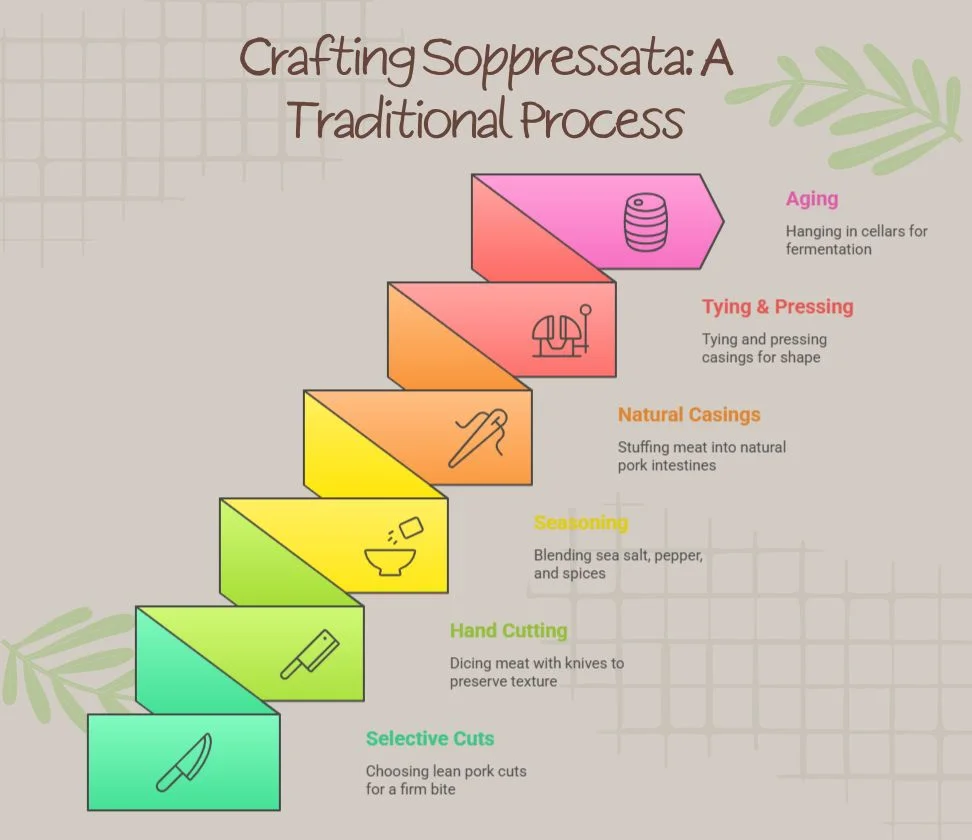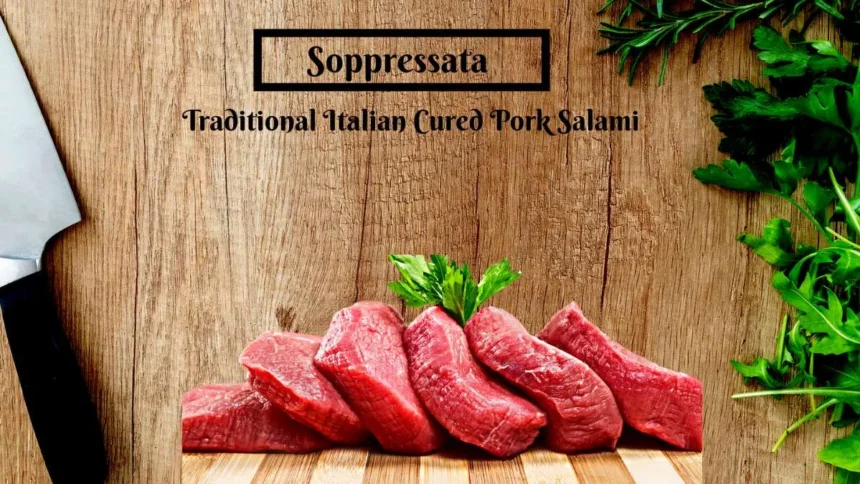Among Italy’s many culinary treasures, Soppressata stands out as a salami that embodies rustic tradition and regional pride. This artisanal cured pork delicacy captivates with its coarse texture, slightly spicy character, and deep, savoury notes. From family kitchens in Calabria to gourmet charcuterie boards worldwide, Soppressata remains a symbol of Italian heritage and slow-food craftsmanship.
Origins and Regional Legacy
The roots of Soppressata reach back centuries, when Italian farmers preserved pork after the annual winter slaughter. Using lean cuts such as haunch, shoulder, and fillet, families hand-cut the meat, seasoned it, and packed it into natural casings.
- Calabria: Known for its bold spice and smoky undertones, Calabrian Soppressata is protected by DOP (Denominazione di Origine Protetta) status, ensuring traditional methods and regional ingredients.
- Puglia and Basilicata: These southern regions favour milder versions, highlighting the pork’s natural sweetness with subtle pepper and herb notes.
- Tuscany and Veneto: Northern variations introduce unique spices like fennel seeds or cloves, offering a distinct aroma and softer texture.
This geographic diversity creates a remarkable spectrum of flavours, all united by a shared respect for time-honoured technique.
Crafting Soppressata: A Traditional Process
The authenticity of Soppressata lies in its meticulous preparation:
- Selective Cuts: Only lean pork cuts, such as haunch, shoulder, or fillet, are chosen to ensure a firm bite.
- Hand Cutting: Meat is diced with knives rather than ground, preserving a coarse, rustic texture.
- Seasoning: A classic blend of sea salt, cracked black pepper, and sometimes local spices.
- Natural Casings: The seasoned meat is stuffed into cleaned, natural pork intestines.
- Tying & Pressing: Casings are tied with natural string and gently pressed, giving Soppressata its signature flattened shape.
- Ageing: Hung in cool, ventilated cellars for about 40 days, allowing natural fermentation and drying to develop complex flavours.
This slow maturation yields a salami that is rich yet balanced, with a pleasant tang resulting from natural fermentation.

Nutritional Profile and Culinary Uses
Soppressata offers a satisfying balance of protein and fat, making it a hearty snack or appetizer. While moderately high in sodium, typical of cured meats, its robust taste means only thin slices are needed to enjoy its character.
Serving Suggestions
- Classic Pairing: Sliced thin with warm, crusty bread and drizzled with extra-virgin olive oil.
- Cheese Boards: Complement aged cheeses like Pecorino Romano or Parmigiano-Reggiano.
- Pickled Companions: Balances beautifully with pickled vegetables or olives.
- Gourmet Dishes: Adds depth to pasta sauces, risotto, or flatbreads.
Properly wrapped in wax paper or vacuum-sealed, Soppressata stays fresh for weeks and sometimes months when stored in a cool pantry or refrigerator.
Regional Varieties at a Glance
| Region | Key Flavor Notes | Special Characteristics |
| Calabria | Spicy, smoky, pepper-forward | DOP status often includes chilli flakes |
| Puglia | Mild, slightly sweet | Subtle herbs, soft texture |
| Basilicata | Earthy, balanced spice | Traditional farmhouse preparation |
| Tuscany | Aromatic with fennel or cloves | Softer, fragrant profile |
| Veneto | Delicate, lightly seasoned | Smooth, gentle flavour |
This diversity allows enthusiasts to explore Italy’s regional character through each slice.
Storing and Savoring
To preserve its quality:
- Keep Soppressata in a cool, dry place or refrigerated between 10–15 °C (50–59 °F).
- Wrap in breathable paper, never plastic, to maintain the natural rind.
- Slice only when ready to serve to protect moisture and aroma.
With proper care, a whole Soppressata can remain flavorful for several months.
Cultural Significance
Soppressata is more than a delicacy; it is a celebration of Italian rural life. Traditionally made after the annual pig slaughter, it represented community effort and seasonal abundance. Today, festivals in Calabria and Puglia still honour this heritage, inviting locals and visitors to taste freshly cured batches and share family recipes passed down for generations.
Sustainability and Modern Appreciation
Artisanal producers increasingly emphasise sustainable farming, free-range pork, and minimal additives. This aligns with the growing consumer demand for ethically sourced, high-quality foods. In gourmet markets worldwide, it has become a sought-after speciality, appearing on charcuterie boards in New York, Paris, and Tokyo, while still rooted in the humble traditions of southern Italy.
Frequently Asked Questions (FAQ)
Q1. What makes Calabrian Soppressata unique?
Calabrian Soppressata holds DOP status and is often spiced with local chilli peppers, giving it a vibrant heat and smoky depth distinct from other regional styles.
Q2. How long does Soppressata last once opened?
When wrapped in wax or butcher paper and refrigerated, opened Soppressata stays flavorful for 2–3 weeks. Keep slices airtight to prevent drying.
Q3. Can Soppressata be cooked, or is it eaten raw?
It is fully cured and ready to eat. However, it can also add rich flavour to cooked dishes like pasta, pizza, or stews.
Conclusion
Soppressata remains a timeless example of Italy’s dedication to craft, flavour, and tradition. Whether savoured as part of a casual antipasto or featured on a gourmet platter, each slice tells the story of regional pride and patient artistry. From the fiery Calabrian hills to the fragrant kitchens of Tuscany, this cured pork salami invites food lovers to taste the essence of Italian culinary heritage, one bite of rich, slightly spicy perfection at a time.






